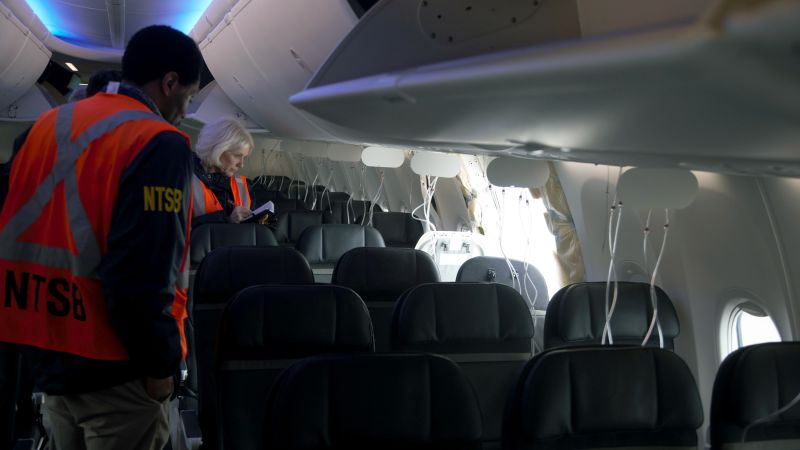Washington, D.C.
CNN
—
The blame for a horrifying mid-flight blowout of a door plug on an Alaska Airlines flight last year is shared by plane manufacturer Boeing, its supplier Spirit Aerosystems and the Federal Aviation Administration, the chairwoman of the National Transportation Safety Board said at a hearing Tuesday.
“The safety deficiencies that led to this accident should have been evident to Boeing and the FAA,” NTSB chairwoman Jennifer Homendy said in opening remarks.
“I have lots of questions where the FAA was during all of this. The FAA is the absolute last barrier of defense when it comes to ensuring aviation safety,” she added.
The blowout occurred minutes into a January 2024 flight from Portland, Oregon, when a door plug blew out the side of the plane at about 16,000 feet. It ripped passengers’ clothing and phones out of the plane — but remarkably, there were no serious injuries on a flight that could easily have turned into a tragedy.
The NTSB’s preliminary findings had already revealed that four bolts that were supposed to hold the door plug in place were missing when the plane was delivered to Alaska Air in October 2023.
During Tuesday’s hearing Homendy praised the crew of the Alaska Air flight several times, calling their actions to get the plane on the ground without any casualties “heroic.”
“This crew shouldn’t have had to be heroes,” she said. “This accident should never have happened. An accident like this only happens when there are multiple system failures.”
The FAA will receive safety recommendations during the board meeting, although it is not required to adopt these recommendations. The agency did not immediately respond to a request for comment on the NTSB’s criticism.
The complete final report on the Alaska Air incident from the NTSB will be available in a few weeks.
Boeing received much of the blame for delivering the plane to Alaska Air without the four bolts needed to hold the door plug in place.
Tuesday’s hearing revealed that the bolts would not have been inspected for another two years, had the incident not occurred. After the accident, Boeing did inspect all planes with the door plugs.
Still, the NTSB report criticized the FAA for what the report termed “inadequate oversight.”
“This isn’t all on Boeing or Spirit,” said Homendy, referring to Spirit AeroSystems, the Boeing supplier that built the plane’s fuselage.
The NTSB report also criticized the FAA for not requiring infants to be restrained while on an aircraft, despite years of recommendations that be required. There were three infants being held on their parents’ laps for this flight, and one of the mothers on the plane told a flight attendant during the incident that she thought she had lost her child out the gaping hole in the plane.
Boeing has replaced its CEO since the incident. Homendy said she has had “several great discussions” with the new CEO, Kelly Ortberg, and praised his actions since he started the job last August.
“He has done a lot of work at Boeing since this accident. He has a lot of work cut out for him, a lot of challenges to address. And that is going to take time,” she said.
Homendy acknowledged that both Boeing and Spirit AeroSystems have implemented new quality control systems, and that she is “grateful for their progress. But you’ll hear today more can and should be done.”
She also hopes new leadership at the FAA and the Department of Transportation will make more efforts to improve safety.
“I believe Boeing, Spirit and the FAA will take the lessons learned from this accident to heart,” she said. “Appropriate oversight (by the FAA) of those they are charged with regulating is critical. I’m hopeful that with new leadership at DOT and the FAA, that will occur.”
Boeing told investigators that there was no internal paperwork showing that the door plug had been removed and then put back in place without the bolts, so workers who were moving the plane along the production line were not aware it needed to have the bolts reattached.
Boeing employees said in interviews with investigators they felt pressure to work too fast, making it difficult to avoid mistakes.
The NTSB hearing Tuesday comes at a fraught time for Boeing, which is now part of an investigation into the fatal crash of a 787 Dreamliner operated by Air India this month.
While there is no indication yet that Boeing’s work caused the crash of the nearly 11-year-old plane, confidence in Boeing could suffer further if the company is found to be even partly at fault.
Boeing has little reputation left to lose after two fatal 737 Max crashes in 2018 and 2019, respectively, were traced back to design and software errors — plus the Alaska Air incident.

